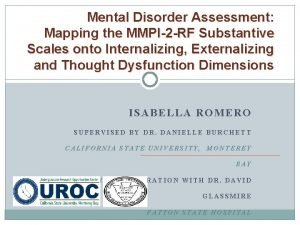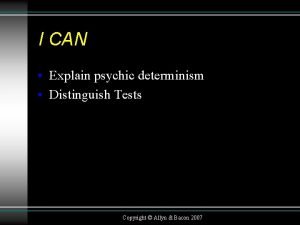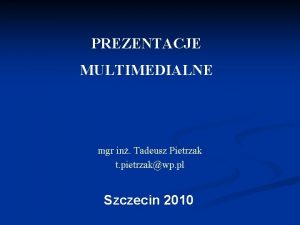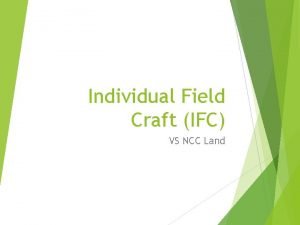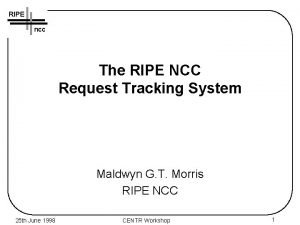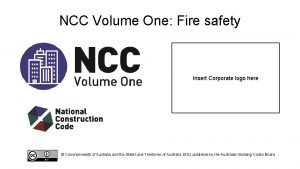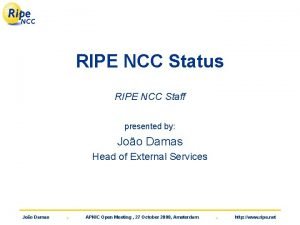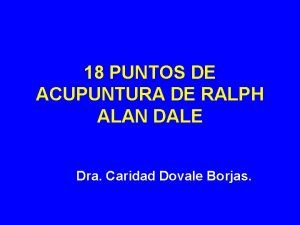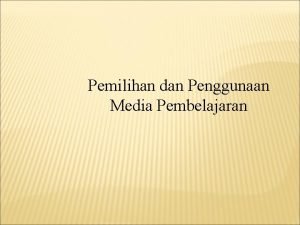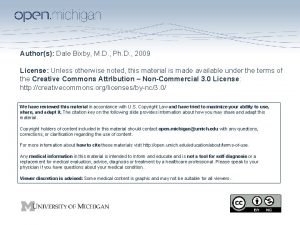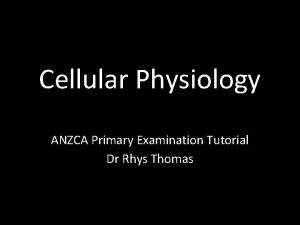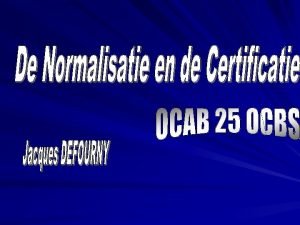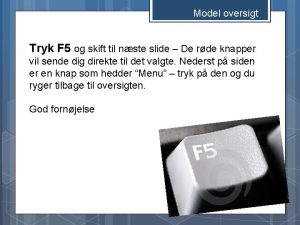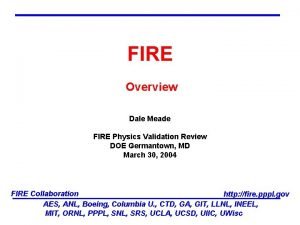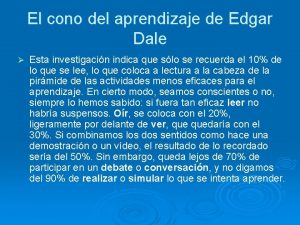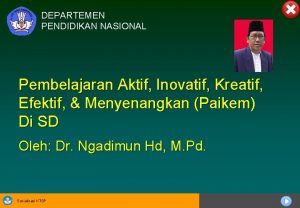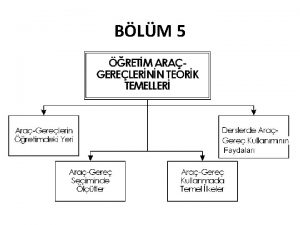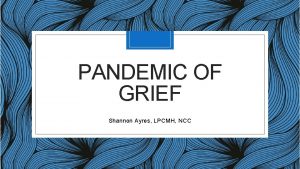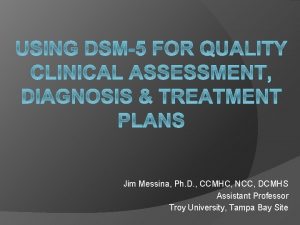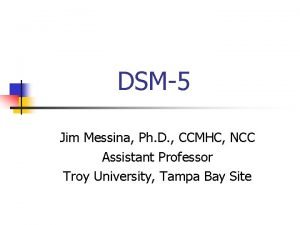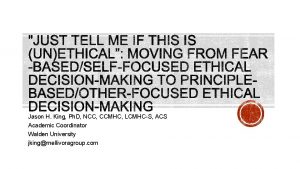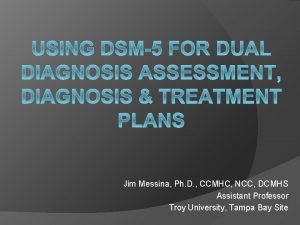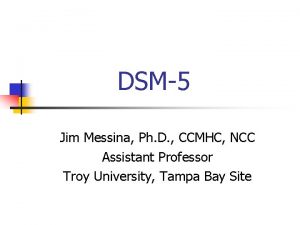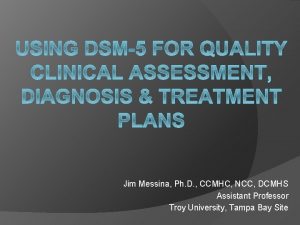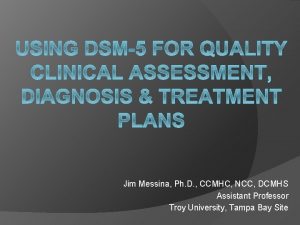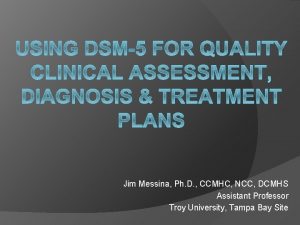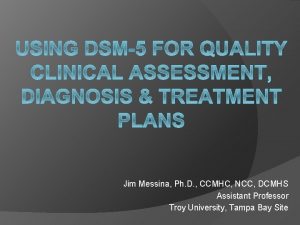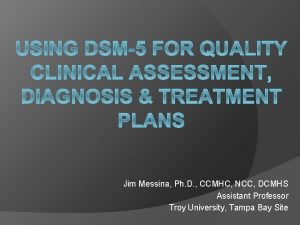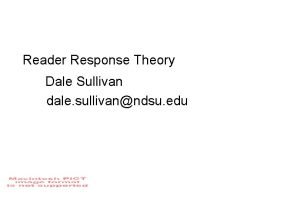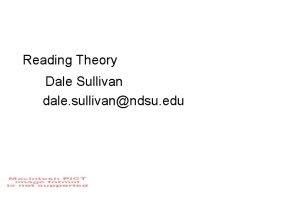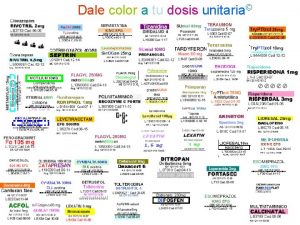MMPI2 Dale Pietrzak Ed D LPCMH NCC CCMHC















































- Slides: 47

MMPI-2 Dale Pietrzak, Ed. D. , LPC-MH, NCC, CCMHC Counseling & Psychology in Education University of South Dakota

MMPI: General • 1 st published in 1943 (Stark Hathaway, Ph. D, & J. Chaney Mc. Kinley, M. D. ) • Group administered procedure to reliably diagnose • Used Empirical keying approach (new at time) Graham (2000) MMPI-2: Assessing Personality & Psychopathology (3 rd ed) Butcher, Et. Al (1989) MMPI-2: Manual for Admin & Scoring

MMPI: Development • About 1000 potential items were collected • Hathaway & Mc. Kinley selected 504 believed to be relatively novel from each other • Appropriate criterion groups were selected – “Minnesota Normals” – “Clinical Subjects” – 504 items administered to groups

MMPI: Development Con’t • Item Analysis (Discrimination Index) used to determine items • Selected items were cross validated • Later 5 (Mf) and 0 (Si) were added

MMPI Validity Scale Development • 3 scales (? , L & F) were originally intended with K added shortly thereafter • ? (Cannot Say): Number of omitted and double marked items • L (Lie): Unsophisticated attempts to present oneself in an overly favorable light • F (Infrequency): Designed to detect deviant test taking behaviors (<10% of normals)

Co n’ t MMPI Validity Scale Development • K (Defensiveness): Meehl & Hathaway (1945) to identify defensiveness – Clinical subjects who scored low for level of pathology were contrasted with “normals” to select items – Later incorporated as a correction factor for basic scales I think my hand is broken!

MMPI Validity Scale Development • F(p): Infrequency-Psychopathology: Try to reduce impact of pathology on F scale. Although officially no cut score set, scores of 100 are seen as cutoff.

Changes Due to Use • 10 years saw MMPI could not do intend job of independent classification accurately • Too many normals scored high • Scales Highly inter-correlated • Approach from pure classification to locating empirical correlates of scales and code types • Scale names dropped in favor of numbers

Need for Revision of MMPI (MMPI-2) • MMPI was consistently ranked as one of the most used instruments • Clinicians (not just “testers”) found it valuable • Several weakness were Identified

MMPI Weaknesses • • • No revision since 1943 Representativness of standardization sample Non-Normal distributions of scales scores Item content dated, bias, or objectionable Insufficient coverage of pathology (drug use, relationships, suicide, etc. ) • 1982 U of M Press appoints restandardization committee (Graham, Butcher, Dalstrom)

Revision Process Form AX (Adults) • 704 total items – 550 original items maintained About time • 82 were rewritten and 15 reworded – 154 new items tried • National Solicitation of Sample – Phone Books, etc. – Paid $15 individual and $40 couple – Emphasis on special populations – 2900 subjects tested 2600 retained

Standardization Sample Characteristics • Under represents the below HS educated (little statistical impact) • 81% Cauc. , 12% Black, 3% Hispanic, 3% Native Am. , 1% Asian Am. • Age: 18 -85 (Mean 41; SD 15) • Education: 3 years to 20+ (Mean 15; SD 2) • Mostly Married I can’t take anymore!

Final MMPI-2 Booklet • • 567 Items Objectionable Items & Bias removed New Scales Developed Most Supplemental and All Clinical Scales Retained Ta Da!

Comparability of MMPI & MMPI-2 • The results of the 2 tests have proven to be generally comparable • The less defined the profile the less reliable the comparison • Greene (1991) suggests conversion to MMPI scores with table K-1 from Manual • Graham says to use individual scales when not clear code type

Administration & Scoring • Advanced degree in mental health, supervised testing (25) and Psychopathology May the force • 1 to 1. 5 hours to take be with you! • 8 th grade reading level • Supervised administration • (No TV or movies, etc. ) • 200+ scales, VRIN/TRIN

Distributions and T-Scores • Non-normal distributions • Uniform T-Scores (Averaged distribution) – Clinical Scales, Content Scales & MDS use Uniform – Supplemental, Harris-Lingoes, Mf and Si use Linear – T of 30 = 99%, T of 50 = 45%, T of 65 = 8%, T of 80 = 1% I’m Back!

MALES Scale 1 Week L. 77 F. 78 K. 84 1 Hs. 85 2 D. 75 3 Hy. 72 4 Pd. 81 5 Mf. 82 6 Pa. 67 7 Pt. 89 8 Sc. 87 9 Ma. 83 0 Si. 92 Stability SEM 1. 0 1. 5 1. 9 1. 5 2. 3 2. 0 1. 6 2. 2 2. 4 1. 8 2. 4 FEMALES Scale 1 Week L. 81 F. 69 K. 81 1 Hs. 85 2 D. 77 3 Hy. 76 4 Pd. 79 5 Mf. 73 6 Pa. 58 7 Pt. 88 8 Sc. 80 9 Ma. 68 0 Si. 91 SEM 1. 0 1. 8 1. 9 2. 4 2. 3 2. 2 2. 3 2. 0 2. 5 3. 5 2. 9 Stability of Basic Scales

Internal Consistency Scale L F K 1 Hs 2 D 3 Hy 4 Pd 5 Mf 6 Pa 7 Pt 8 Sc 9 Ma 0 Si Males. 62. 64. 77. 59. 58. 60. 58. 34. 85. 58. 82 Females. 57. 63. 72. 81 Did you. 64 see that!. 56. 62. 37. 39. 87. 86. 61. 84

MMPI-2 Interpretation Process • Determine Profile Validity • Configural (Code types) • Content (Basic, Content, and Supplemental) As easy as 1, 2, 3. . . Yah! right. . .

Validity scales: General Guidelines • ? 30+ Definitely Invalid; 10+ Great Caution • L > 65 probably Invalid • F, Fb >100 Likely Invalid (Highly correlated with severity of pathology) • K > 70 Invalid (Correlated with ego Strength) • F(p)> 100 Invalid

Validity scales: General Guidelines • VRIN > 80 Invalid • TRIN > 80 Invalid I think I would rather be home. Co n ’t

Deviant Response Sets: General • • Random: F >100, Fb >100, F(p)> 100 VRIN >80 All True: F > 100, Fb > 100, TRIN > 80 All False: L > 65, F > 100, Fb > 100, TRIN > 80 Negative Impression: F > 100, F(p) < 100, K Low, VRIN & TRIN Acceptable; • Exaggeration: Clinical Judgment • Positive Impression: L > 65, K > 65, Low F Defensiveness: K & L 10 points higher than F; either F or K elevated (experimental: S [superlative] greater than 29).

Interpretation Examples • Random – VRIN=98, F=103 and F(p)=99 • Fake Good – K=70, L=67 and S=68 • Fake Bad – F=110, F(p)=78 often L, K & S are very low

Configural Information: Slant • Level of F and profile elevation • Left of Profile elevated “neurotic slope” • Right of Profile Elevated more sever pathology • Conversion “V” (1 & 3 elevated with 2 lower) • Psychotic valley (6 & 8 Elevated with 7 lower) • Cry for Help (2 -7)

Configural Information: Code Types • Use the highest 2 or 3 scales (NOT including 5 or 0) • If over 65 think more pathology, if under think more “normal” expression of configuration • Highest scale determines but all scales within 5 to 7 points are interchangeable • Most codes order is not vital

Basic Clinical Scales • 1: Hypocondrical complaints • 2: subjective depression, psychomotor retardation, physical symptoms, mental dullness & brooding • 3: denial of social anxiety, need for affection, general icky feelings, somatic complaints, inhibition of anger

Basic Clinical Scales Con’t • 4: family discord, authority problems, social imperturbability, social alienation and self-alienation • 5: stereotypic gender interests, sexuality • 6: persecutory ideas, hypersensitivity, naive trust I have an idea about what to do to this presenter. .

Basic Clinical Scales Con’t • 7: anxiety and compulsivity • 8: concentration, thought disorders, creativity, social alienation, apathy, depression, lack of emotional control & hallucinations • 9: manipulative, distrust, Over activity, imperturbability & ego inflation

Basic Clinical Scales Con’t • 0: shyness, self-consciousness, social avoidance, alienation Sounds like me after this class.

Content Scales: General • More stable and consistent than clinical scales • Graham see these scales as more meaningful than the clinical scales in many ways (“T” greater than 65) • Good validity for the scales • Content is obvious and so can be manipulated

Content Scales • Anx General Anxiety • FRS Specific fears • OBS Compulsive, problems with decisions, rigidity, ruminate • DEP Down, fatigued, pessimistic • HEA Feel unhealthy, health preoccupation I think the rust is out.

Content Scales Con’t • BIZ psychotic thinking, hallucinations, paranoia • ANG anger, hostility, grouchy, easily frustrated • CYN sees others as selfish & self-centered, guarded, hostile, resent mild demands • ASP legal/school trouble, believe breaking law is acceptable, resent authority, anger

Content Scales Con’t • TPA: hard-driven, work-oriented, sees more to be done, impatient, irritable, critical, hold grudges • LSE poor self-concept, expect to fail, quit, hypersensitive, passive, poor at making decisions • SOD: shy, rather be alone

Content Scales Con’t • FAM: family discord, resent or angry at family • WRK: poor work attitudes and behaviors • TRT: negative attitudes towards mental health treatment & doctors, give up easily I hate them. . .

Supplemental Scales: General • Each tends to have been developed independently using various methods • Generally use linear T-scores (MDS uses uniform) • Generally good reliability and validity I surrender!

Supplemental Scales • Anxiety (A) and Repression (R) – Developed using factor analysis. These are the 2 strongest factors. – A- thinking & thought processes, negative emotional tone, pessimism & lack of energy – R-health, emotionality, violence, activity, reactivity, dominance, adequacy – Quadrant interpretation

Supplemental Scales Con’t • Ego Strength (Es) : – When defensive artificially high – improvement of neurotics but fail cross validation – Seems to be general emotional stability I’ll show you ego strength!

Supplemental Scales Con’t • Mac. Andrew Alcoholism Scale (MAC-R): – 28+ substance abuse problems (24 -27 suggestive), 24 or less not likely • Addiction Acknowledgment Scale (AAS): – T > 60 openly acknowledge substance abuse problems

Supplemental Scales Con’t • Addiction Potential Scale (APS): – T > 60 possible substance abuse • Marital Distress Scale (MDS): – T > 60 indicate possible marital discord • Overcontrolled-Hostility (O-H): – Theory of overcontrol and hostility (prison) – T > 70 intrapunative, repress, self-depreciative

Supplemental Scales Con’t • Dominance (Do): – T > 70 tend to be confident in self to dominant • Social Responsibility (Re): – T > 70 willing to accept personal responsibility, ethical, even rule bound • College Maladjustment (Mt): – T > 70 pessimistic, procrastinate, ineffectual

Supplemental Scales Con’t • Masculine Gender Role (GM) and Feminine Gender Role (GF) : – Experimental – Quadrant interpretation? – T > 70 indicate stereotypic attitudes So what is the point?

Supplemental Scales Con’t • Post-traumatic Stress Disorder Scale (PK): – T > 70 many PTSD symptoms • Post-Traumatic Stress Disorder Scale (PS) – Experimental Fire one!

Other Scales • • • Subtle-Obvious Harris-Lingoes Content Component Subscales Personality Disorder scales Over 300 other scales Doesn’t he ever stop? !

Critical Item Lists • Suicide: – 75(F), 303(T), 506(T), 520(T), & 524(T) • Assault: – 27(T), 37(T), 85(T), 134(T), 213(T), & 389(T)

Special Populations • No adolescents (MMPI-A: 20 -25% 8 th grading reading level) • Historically the MMPI has had certain scales which score differently for minorities – Bias Vs Environmental responses (Sue & Sue) • Little statistical evidence there are consistent differences with the MMPI-2 • Not to be used to screen for organic disorders

Evaluation • Good standardization sample • Great research on validity • Major test used in area • Little bias • Recent revision • Reliability • Form length could provide more information • No data on normal personality • Scale inter-correlations & Item overlap

I survived the MMPI-2!
 Mmpi2
Mmpi2 Multidimensional calm test
Multidimensional calm test Mmpi2.htm
Mmpi2.htm Elżbieta pietrzak fotografia
Elżbieta pietrzak fotografia Tadeusz pietrzak
Tadeusz pietrzak Essay on ncc
Essay on ncc Perbedaan nuc dan ncc
Perbedaan nuc dan ncc Dr somer shely
Dr somer shely Local guide program
Local guide program New city college
New city college Halving method judging distance
Halving method judging distance Ncc street lighting
Ncc street lighting Request tracking system
Request tracking system Fire resistance level ncc
Fire resistance level ncc My ncc portal login
My ncc portal login Ripe database download
Ripe database download Ncc business permit
Ncc business permit Webmail.metu.edu.tr
Webmail.metu.edu.tr Ncc trade cred new
Ncc trade cred new Ncc status
Ncc status Dale voorhees
Dale voorhees Manual de los 18 puntos de acu digitopuntura pdf
Manual de los 18 puntos de acu digitopuntura pdf Dale rand
Dale rand Kerucut pengalaman edgar dale
Kerucut pengalaman edgar dale Dale bixby
Dale bixby Rang and dale
Rang and dale El cono de la experiencia
El cono de la experiencia Dale han md
Dale han md Norme larousse
Norme larousse Dale county softball
Dale county softball Læringssyn oversigt
Læringssyn oversigt Dale meade
Dale meade What are contrived experiences?
What are contrived experiences? Cono del aprendizaje
Cono del aprendizaje Dale sanftl
Dale sanftl Kerucut pengalaman edgar dale hd
Kerucut pengalaman edgar dale hd Dale and betty bumpers
Dale and betty bumpers Dale meade
Dale meade Tord dale
Tord dale Dale botting
Dale botting Dael jaecques
Dael jaecques One sky center
One sky center Dale ormond
Dale ormond Cono edgar dale
Cono edgar dale Dale gary
Dale gary Dale carnegie conversation stack
Dale carnegie conversation stack Dale nin yaşantı konisi
Dale nin yaşantı konisi Dale sanders health catalyst
Dale sanders health catalyst
